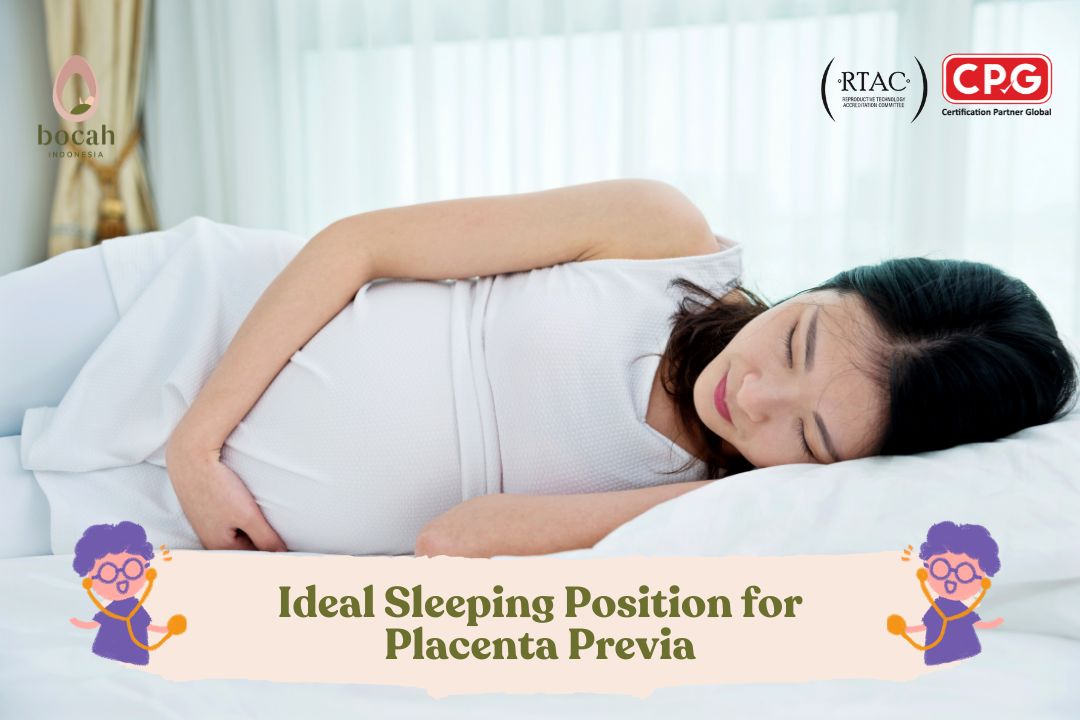Ideal Sleeping Position for Placenta Previa

Certain medical conditions, such as placenta previa, can make pregnancy more challenging. Learn more about it here.
Placenta previa occurs when the placenta attaches too close to, or even covers, the cervix, which can cause bleeding and complications during delivery. One important aspect that requires careful attention for moms experiencing placenta previa is the sleeping position.
While sleeping position won’t entirely eliminate the risks associated with placenta previa, the right position can help reduce discomfort and minimize the risk of bleeding. Learn more about the ideal sleeping positions for placenta previa and other tips to consider during pregnancy here.
What is Placenta Previa?
Placenta previa is a condition where the placenta, which is typically located at the top of the uterus, attaches lower down, near the cervix or even completely covers it. This condition can cause problems during childbirth because the placenta obstructs the birth canal, preventing the baby from being delivered vaginally.
Placenta previa can cause heavy bleeding, especially during labor. In some cases, the condition may resolve on its own over time, but in other cases, a cesarean section may be necessary to deliver the baby safely.
Tanya Mincah tentang Promil?
Regular check-ups and monitoring by a healthcare provider are crucial to managing placenta previa appropriately.
Why is Sleeping Position Important?
Pregnancy brings significant physical changes to a woman’s body. In the case of placenta previa, the placenta covering part or all of the cervix can increase the risk of bleeding, early contractions, and premature birth.
Therefore, it is essential to be cautious about choosing a sleeping position to avoid excessive pressure on the placenta or the sensitive areas of the abdomen.
Additionally, incorrect sleeping positions can worsen back pain and affect sleep quality. Adequate and restful sleep is crucial for supporting both maternal and fetal health. Moms undergoing fertility treatments should ensure they maintain good sleep quality, as sufficient sleep can positively impact fertility and overall health during pregnancy.
Recommended Sleeping Positions
If you’re experiencing placenta previa, here are some ideal sleeping positions to consider:
1. Sleep on Your Left Side
One recommended sleeping position for moms with placenta previa is sleeping on the left side. This position helps improve blood flow to the placenta and the fetus while reducing pressure on the inferior vena cava (the main blood vessel that returns blood from the lower body to the heart).
Sleeping on the left side can help improve circulation, which is essential for the health of both the mother and the baby. This position can also reduce swelling in the legs and avoid putting pressure on other vital organs such as the kidneys and liver.
If you find it uncomfortable to maintain one position all night, use pillows to support your body to keep it stable and comfortable.
2. Use Pillows for Support
Moms with placenta previa are also advised to use special pillows, such as pregnancy pillows, to help maintain a comfortable and safe sleeping position. These pillows can be placed between the knees or under the belly to provide additional support and reduce pressure on the abdomen and back.
Pillows can help prevent rolling onto your back during sleep, which can be dangerous for pregnant women with placenta previa. The right pillow can also help improve sleep quality, reduce back pain, and keep the body relaxed.
3. Avoid Sleeping on Your Back
Sleeping on your back should be avoided by moms with placenta previa. This position can put additional pressure on large blood vessels, such as the inferior vena cava, disrupting blood flow to the fetus and causing dizziness or even fainting in the mother.
Additionally, sleeping on your back can increase the risk of bleeding in placenta previa by pressing on the placenta. To prevent this, ensure that you sleep on your side and avoid back sleeping, especially in the second and third trimesters.
4. Sleep in a Semi-Sitting Position
Some moms feel more comfortable sleeping in a semi-sitting position, particularly if they experience symptoms such as nausea or difficulty breathing. By slightly raising the upper body with pillows, you can sleep more comfortably while avoiding pressure on the abdomen.
This semi-sitting position can also help prevent tightness in the abdomen caused by pressure from the placenta or the growing fetus. Moms who feel nauseous or frequently vomit at night can try this position to achieve better sleep.
Consider Sleep Quality
In addition to choosing the right sleeping position, it’s important to pay attention to the quality of your sleep. Adequate rest is vital during pregnancy, especially if you are undergoing fertility treatments. Sleep deprivation can affect hormones and overall health.
To support better sleep quality, here are a few tips:
-
Establish a consistent sleep routine: Going to bed at the same time each night helps your body adapt and get deeper sleep.
-
Avoid caffeine and heavy meals before bed: Stay away from caffeine, sodas, and heavy meals that can interfere with sleep.
-
Create a comfortable sleep environment: Ensure your bedroom is dark, cool, and free from disturbances to promote restful sleep.
When to Contact Your Doctor
If you experience discomfort or symptoms like bleeding or severe abdominal pain, contact your doctor immediately. The doctor will provide more specific guidance on the correct sleeping positions or any other medical interventions that may be necessary.
Placenta previa can carry high risks, so it’s essential to receive proper medical care to ensure the health of both the mother and the baby. Don’t hesitate to consult with your doctor about any symptoms you experience and what can be done to keep your pregnancy healthy.
Choosing the right sleeping position is a crucial aspect of maintaining health for moms with placenta previa. Sleeping on the left side with pillow support can help improve circulation and reduce pressure on the placenta. Avoid sleeping on your back, as this can apply pressure to the placenta and harm the fetus.
Additionally, pay attention to the quality of your sleep and ensure you are getting enough rest to stay healthy during pregnancy. If you have further questions or concerns, feel free to consult with your doctor for advice tailored to your specific condition.
Source:
- Jenabi, E., et al. (2022). The Risk Factors Associated with Placenta Previa: An Umbrella Review. Placenta, 117, pp. 21–7.
- Petpichetchian, C., et al. (2018). Comparison of Transabdominal and Transvaginal Sonography in the Diagnosis of Placenta Previa. Journal of Clinical Ultrasound, 46(6), pp. 386–90.
- Centers for Disease Control and Prevention (2020). Venous Thromboembolism (Blood Clots).
- Mayo Clinic (2020). Diseases & Conditions. Placenta Previa.
- Cassoobhoy, A. WebMD (2020). Placenta Previa.
- Johnson, S. Healthline (2021). Placenta Previa.
- Stöppler, M. MedicineNet (2021). Placenta Previa Symptoms, Types, Causes, Treatment, Management, and Complications.



